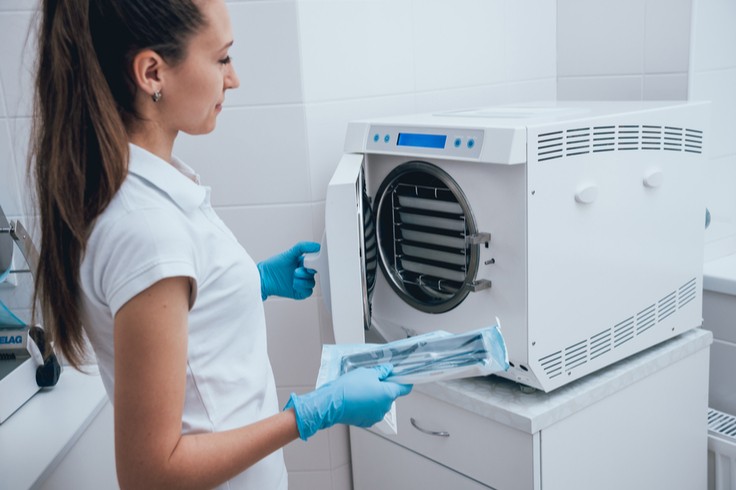
What is autoclave sterilization? The simplest explanation is that it is a highly effective method of sterilizing and disinfecting objects through the use of heat — in the form of steam — plus pressure and time.
In an autoclave, objects or instruments that have been exposed to contaminants such as microorganisms, spores or biological material are placed in a chamber. The machine is then pressurized and filled with steam. This pressure raises the temperature of the steam to the required level — typically between 121° C and 134° C — and ensures that every part of the instrument can be sterilized by maintaining the pressure and temperature for a predetermined amount of time.
What Is the Purpose of an Autoclave?
Autoclaves were developed to clean tools that could not be sterilized with heat or detergents alone. Thanks to the pressurization component of the process, an autoclave can reach steam temperatures higher than normal, which allows them to operate relatively quickly and decontaminate all parts of an instrument. The use of steam under pressure at elevated temperatures means this process is highly effective in killing bacteria, fungi, viruses, and resilient spores that may not be eliminated using other methods. In addition, today’s autoclaves easily facilitate verification of the procedure using temperature-sensitive tape and other indicators. This means facilities using steam sterilizers are more likely to meet regulatory requirements.
A steam autoclave is most frequently used in medical centers and hospitals, dental offices, laboratories, and research facilities. It is also useful, however, in any scenario where reusable equipment must be sterilized. Businesses such as food and beverage proprietors, veterinarians and even barbershops or beauty salons could benefit from an autoclave.
The Autoclave Process
Here, we’ll take a look at the cleaning process, including how to operate an autoclave for sterilization. We’ll also answer some frequently asked questions about the technique.
Autoclaves generally follows these steps:
- Objects or instruments (also called load materials) to be sterilized are placed in an autoclave-compatible bag and then into a secondary container. This will help prevent contact with the walls of the autoclave, which could melt plastic components.
- Once packaged, the vessel is placed in the autoclave.
- The operator closes and locks the autoclave, then selects the correct cycle for the type of material to be sterilized.
- The autoclave is pressurized, fills with steam, and begins to approach the specified temperature for the cycle.
- Once it reaches the sterilization temperature the autoclave will keep the chamber at that temperature for the full sterilization cycle duration.
- Operators should confirm that the required temperature is consistently met for the entire duration of the sterilization period.
- Once the cycle is complete, the autoclave will enter a cooling mode where it will slowly depressurize and return to room temperature. Many autoclaves won’t open until their internal temperature reaches a safe level
- Check any verification measures, such as temperature tape.
- Remove the tools and let stand in a designated “hot zone” until cooled to room temperature, then transport as needed.
To answer a few common questions about the autoclave:
- What makes up a sterilization cycle? Each sterilization cycle has various parameters associated with it. These are typically based around a specific load configuration or material type. The parameters the autoclave uses are pressure, temperature, and time. For instance, a gravity displacement autoclave operates at 121° C for about 30 minutes, while a pre-vacuum autoclave cycle may operate 134° C for shorter durations depending on the load.
- How long does an autoclave take to sterilize? In general, each cycle will take between 60 to 90 minutes. The sterilization duration varies, but is typically around 30 minutes, and the remaining cycle time is split between heating up and cooling down the autoclave chamber.
- On what is an autoclave effective? The sterilization process kills bacteria, viruses and bacterial spores. Biological indicators and lethality calculations can be used to validate a cycle for an autoclave.
- Can the process fail? It can, for a variety of reasons. Read on to learn why and what to do in such a circumstance.
What to Do if an Autoclave Fails
An autoclave can be unsuccessful for a number of reasons, most commonly:
- Improper calibration of the machine, leading to temperature or pressure fluctuation
- Operating without re-validation after the device has been modified or moved, which may violate GMP or ISO expectations
- Incorrect cycle selection for the load materials, or using a non-validated cycle
- Low-quality steam, or vapor that is too high in water content or has been heated beyond the most efficient sterilization temperature for the autoclave (generally 134° C)
- Improper packaging or positioning of materials to be sterilized
Modern autoclaves include verification measures such as temperature-sensitive and/or chemical-indicator tapes, control vials containing biological contaminants and more. By confirming the success of sterilization, operators and facilities can easily detect whether maintenance, calibration or other measures are needed to service the equipment. Many autoclaves come with pre-validated cycles that are proven by the manufacturer to sterilize certain types of loads. Custom cycles can also be validated by the end users for process specific materials and loads.
Calibration and More with Technical Safety Services
Technical Safety Services offers assistance to laboratories, medical facilities and other controlled environments to ensure that your equipment is operating properly. Our services include comprehensive equipment qualification, cycle development, performance qualification support, ongoing calibration, and more. In addition to regular maintenance and calibration services, we also provide clients with audit-ready digital records that support compliance with 21 CFR Part 11 and other critical regulatory frameworks.
Whether your autoclave is configured for a laboratory, GMP suite, or high-volume reprocessing center, we provide the expertise needed to ensure it delivers the proper performance for quality assurance and compliance. We can help you schedule a consulting review of your qualification status, design a validation page, or begin a calibration program tailored to your needs. For more information, contact us today.

